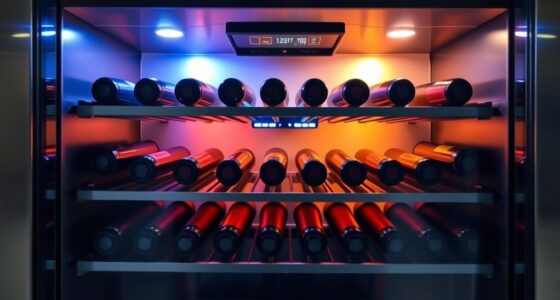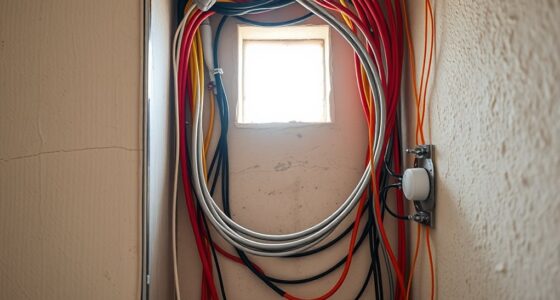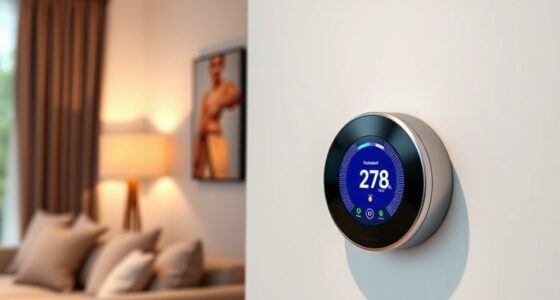HEPA filters trap germs through a combination of mechanical interception, impaction, and diffusion. As air passes through the densely layered fibers, larger particles are caught on the surface, while smaller germs and bacteria are captured within the filter layers. Electrostatic attraction also helps draw tiny particles toward fibers. Proper fiber arrangement and maintenance guarantee continuous effectiveness. If you want to understand how these processes work together to keep your air cleaner, there’s more to explore.
Key Takeaways
- HEPA filters trap germs through mechanical filtration and electrostatic attraction, capturing particles as small as 0.3 microns.
- Dense, layered fibers create a large surface area that intercepts airborne germs via multiple filtration mechanisms.
- Particles are captured through interception, impaction, and diffusion, effectively trapping bacteria and viruses of various sizes.
- Maintaining static charge on fibers enhances their ability to attract and retain microscopic germs.
- Proper filter maintenance and timely replacement ensure sustained germ filtration efficiency and air quality.
The Composition and Structure of HEPA Filters

HEPA filters are made from a dense mat of fine fibers, typically composed of fiberglass or synthetic materials like polypropylene. The filter material is carefully selected for its ability to trap tiny particles, including germs. During the manufacturing process, fibers are randomly arranged into a compact, layered structure that maximizes surface area. This dense network creates a high level of filtration efficiency, capturing particles as small as 0.3 microns. The manufacturing process also involves pleating the filter material to increase surface area without enlarging the filter’s size, improving airflow and filtering capacity. The combination of fiber type and precise construction guarantees HEPA filters can effectively trap germs and other airborne contaminants, making them essential for clean air environments. Additionally, high surface area enhances the filter’s ability to capture a broader range of particles, increasing overall effectiveness.
The Principles Behind Particle Capture

You’ll see how HEPA filters trap particles through mechanical filtration, where fibers catch debris as air passes through. Additionally, electrostatic attraction enhances this process by drawing charged particles toward the filter fibers. Together, these principles guarantee effective removal of germs and airborne contaminants. In fact, understanding the security of home security systems can help ensure your environment remains safe and protected.
Mechanical Filtration Mechanics
Mechanical filtration relies on physical barriers to trap airborne particles as the air passes through the filter material. You can understand this process through airflow dynamics, which determine how air moves and particles collide with the filter fibers. The filter layering enhances particle capture by creating multiple obstacle levels, increasing the chance of interception. As air flows through, larger particles get caught on the surface, while smaller ones are trapped within the layers. The key mechanisms include direct interception, inertial impaction, and diffusion. These work together to efficiently remove germs and dust. By optimizing airflow and filter layering, HEPA filters maximize particle retention. This straightforward physical process is what makes mechanical filtration a reliable method for trapping germs and other airborne contaminants.
Electrostatic Attraction Effect
Electrostatic attraction plays an essential role in enhancing particle capture within filters by charging particles and fibers, causing them to attract each other through electrical forces. When particles pass through a filter, they acquire an electrostatic charge, and the fibers themselves may hold a static charge. This electrostatic attraction pulls particles toward the fibers, increasing the likelihood of capture beyond simple mechanical means. Over time, charge neutralization can occur if particles or fibers lose their static charge, reducing filter efficiency. However, many HEPA filters are designed to maintain their electrostatic properties for extended periods. This effect helps trap tiny particles, including germs and allergens, with greater effectiveness, making electrostatic attraction a crucial principle behind the superior filtration capabilities of HEPA technology. Additionally, maintaining the static charge of the fibers enhances the filter’s ability to attract and retain microscopic contaminants.
Interception: Snaring Particles Along the Filter Fibers

Have you ever wondered how HEPA filters trap tiny particles without relying solely on static electricity? It’s all about interception, a process where airborne particles get caught through fiber interaction. As air flows through the filter, particles follow the airflow and come into contact with fibers. If they come close enough, they get snared without bouncing off or passing through.
A key aspect of HEPA filter efficiency is the fiber interaction that enables effective trapping of particles.
Key points include:
Interception captures mid-sized airborne particles efficiently through fiber contact.
- Small particles drift close enough to fibers for interception to occur.
- The fibers’ surface acts as a barrier, capturing particles on contact.
- This method is especially effective for mid-sized airborne particles that are too small for impaction but too large for diffusion.
Through fiber interaction, interception plays a fundamental role in trapping germs and debris efficiently.
Impaction: Trapping Larger Germs and Debris

While interception effectively captures mid-sized particles, larger germs and debris rely on impaction to be trapped. As airflow patterns change around filter fibers, bigger particles can’t follow the air’s curves and collide directly with the fibers, leading to germ adhesion. Impaction is especially effective for particles over 0.3 micrometers, which are less affected by diffusion. The table below highlights key factors influencing impaction:
| Particle Size | Airflow Speed | Germ Adhesion Effectiveness |
|---|---|---|
| Larger Germs | High | High |
| Debris | Moderate | High |
| Medium Germs | Low | Moderate |
| Tiny Particles | Very low | Low |
| Dust | Varies | Moderate |
Impaction ensures larger contaminants are captured efficiently, improving overall filter performance. Additionally, airflow dynamics play a crucial role in enhancing the impaction process by directing particles toward fibers more effectively.
Diffusion: Absorbing Tiny, Randomly Moving Particles

Tiny particles, such as bacteria and some viruses, move randomly due to Brownian motion, making them harder to capture with impaction or interception alone. This is where diffusion plays a key role. Airborne microorganisms exhibit unpredictable particle behavior, causing them to drift in all directions. When they collide with the filter fibers, they become trapped even if small enough to avoid other mechanisms.
Additionally, the pressure gradient created by airflow through the filter enhances the likelihood of these tiny particles being drawn into the fibers.
- Enhances removal of ultrafine particles that evade impaction and interception
- Relies on the constant, random movement of particles
- Is especially effective for tiny, lightweight microorganisms
This process increases the overall efficiency of HEPA filters in capturing even the smallest airborne microorganisms, ensuring cleaner, healthier air.
The Role of Fiber Density and Arrangement
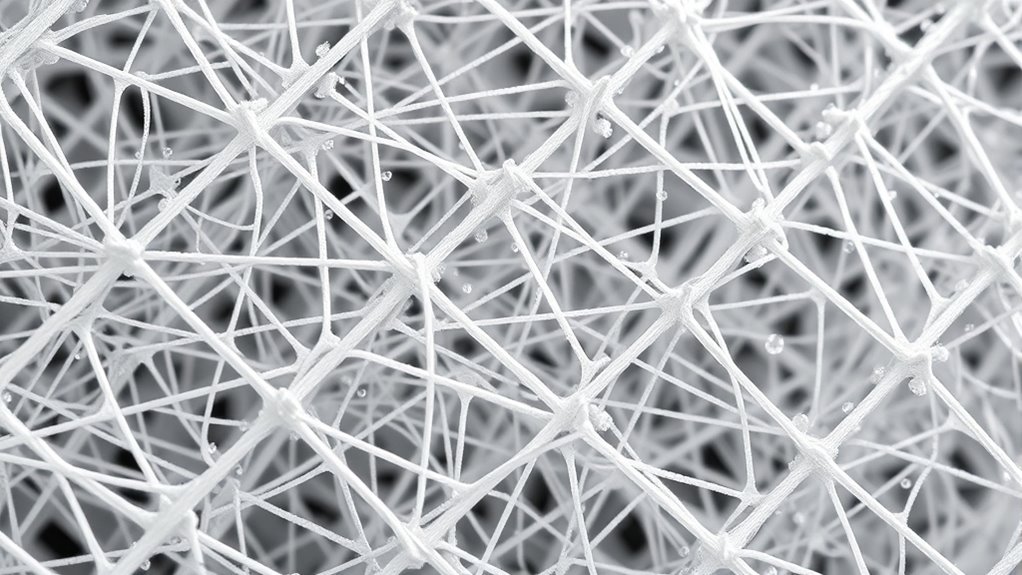
The density and arrangement of fibers within a HEPA filter directly influence its ability to trap airborne germs. When fibers are packed closely together, the pore size—the gaps between fibers—becomes smaller, making it harder for germs to pass through. The fiber arrangement determines how effectively particles are captured through interception, impaction, and diffusion. A well-designed arrangement ensures a uniform pore size, maximizing surface contact and reducing bypass. If fibers are too sparse, larger pores allow germs to slip through; if too dense, airflow drops, reducing efficiency. Proper fiber density and arrangement strike a balance, optimizing filtration without overly restricting airflow. This precise structuring is fundamental to HEPA filters’ high germ-trapping performance. Additionally, fiber density plays a crucial role in maintaining airflow efficiency while ensuring maximum germ capture.
How HEPA Filters Handle Different Particle Sizes

How do HEPA filters manage to capture particles of various sizes? It all comes down to airflow dynamics and how particles interact with the filter fibers. HEPA filters use three main mechanisms:
- Interception: Larger particles follow airflow and get caught as they come into contact with fibers.
- Impaction: Very large or fast-moving particles collide directly with fibers and are trapped.
- Diffusion: Tiny particles, like germs, move randomly due to Brownian motion, increasing their chances of being captured. Additionally, filter efficiency depends on the precise arrangement of fibers and the maintenance of airflow to optimize particle removal.
These combined processes ensure a broad particle size range is filtered effectively. As particles are trapped, airflow slows slightly, which can impact filter lifespan if not maintained. Understanding these mechanisms helps you appreciate how HEPA filters efficiently handle different particle sizes, including germs.
Factors Affecting Filter Efficiency and Performance
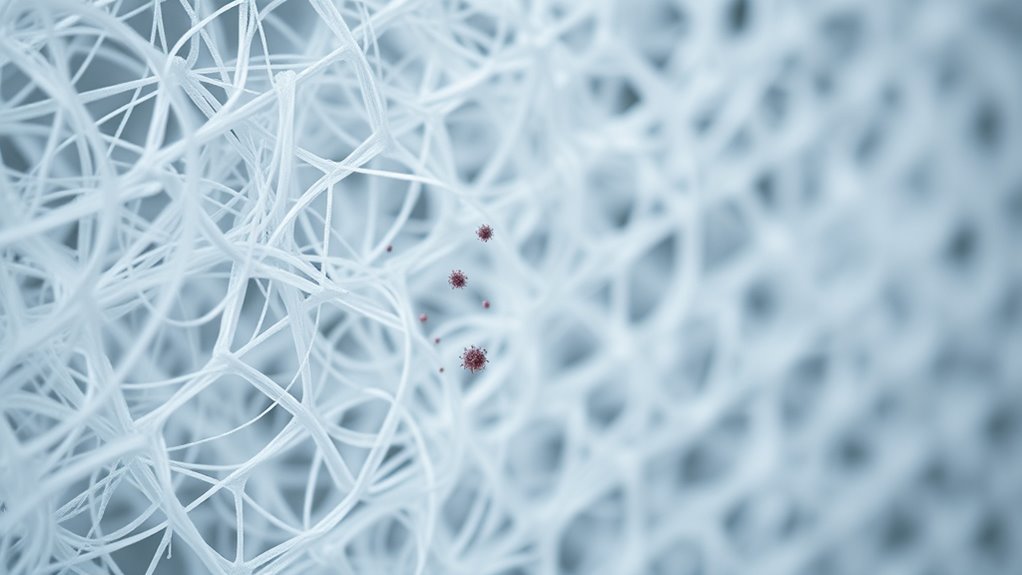
Several factors influence how effectively a HEPA filter performs, and understanding these can help you maximize its use. Key elements include airflow optimization, which ensures particles pass through efficiently without bypassing the filter, and filter material durability, affecting longevity and filtration quality. If airflow is too high, particles might not be captured properly; too low, and it reduces efficiency. The durability of the filter material determines how well it maintains its structure and filtering ability over time. Consider this table for a clearer picture:
| Factor | Impact |
|---|---|
| Airflow Optimization | Balances particle capture and system efficiency |
| Filter Material Durability | Maintains performance over extended use |
| Particle Size | Larger particles are easier to trap; smaller particles require ideal conditions |
Properly managing these factors maximizes your HEPA filter’s performance.
The Importance of Regular Maintenance and Replacement

Regular maintenance and timely replacement are crucial to guarantee your HEPA filter continues to perform at its best. Over time, the filter’s lifespan diminishes, reducing its ability to trap germs effectively. Neglecting maintenance can lead to contamination buildup, making it less effective and potentially spreading germs instead of trapping them. To ensure maximum performance, check your filter regularly and replace it when needed. Proper care also involves understanding the performance of real couples, as shared experiences can impact the longevity of relationships and, similarly, the effectiveness of your air filtration system. Key tips include:
- Replacing filters before the recommended lifespan expires
- Cleaning surrounding areas to prevent dirt buildup
- Monitoring for signs of reduced airflow or musty odors
These steps help prevent contamination, keep your air clean, and maintain your filter’s efficiency. Regular upkeep isn’t just about longevity; it’s essential for ongoing germ and pollutant prevention.
Frequently Asked Questions
Can HEPA Filters Remove Viruses From the Air Effectively?
You want to know if HEPA filters can remove viruses from the air effectively. Yes, they excel at virus filtration, capturing particles as small as 0.3 microns with about 99.97% efficiency. For air purification, HEPA filters are highly reliable, trapping airborne germs, including many viruses, to improve your indoor air quality. Keep in mind, proper filter maintenance and good ventilation are key to maximizing their effectiveness.
How Long Do HEPA Filters Typically Last Before Replacement?
You wonder about the filter lifespan and replacement frequency of HEPA filters. Typically, HEPA filters last between 6 to 12 months before they need replacement, depending on usage and air quality. Regularly checking and changing your filter guarantees maximum efficiency. You should replace it sooner if you notice reduced airflow or increased dust buildup. Proper maintenance keeps your air purifier working effectively and helps protect your health.
Are HEPA Filters Effective Against Chemical Pollutants?
You might wonder if HEPA filters are effective against chemical pollutants. While they’re excellent at pollutant removal of airborne particles and allergens, HEPA filters aren’t designed for chemical filtration. For chemical pollutants, you’ll want activated carbon filters, which absorb gases and odors. So, combining HEPA with activated carbon filtration provides thorough air purification, tackling both particulate matter and chemical contaminants effectively.
Do HEPA Filters Produce Ozone or Other Harmful Byproducts?
You might wonder if HEPA filters produce ozone emissions or harmful byproducts. Generally, HEPA filters don’t generate ozone or other harmful byproducts during operation. However, some air purifiers with certain ionizing features can produce small amounts of ozone, which may be harmful in high concentrations. To prevent this, choose HEPA filters without ionizer functions and ensure your device complies with safety standards.
Can DIY Cleaning or Maintenance Damage HEPA Filter Performance?
You might wonder if DIY cleaning or maintenance can damage your HEPA filter’s performance. If you’re not careful, it can compromise filter integrity, reducing its ability to trap germs effectively. Using harsh chemicals or improper handling can cause tears or deform the filter media. To avoid maintenance impact, always follow manufacturer instructions, gently clean when needed, and replace filters as recommended to keep your HEPA filter functioning effectively.
Conclusion
Understanding how HEPA filters trap germs is like revealing a secret garden maze—each fiber and mechanism working together to block tiny invaders. By grasping their design and maintenance needs, you become a vigilant guardian of clean air. Keep your filter in top shape, and it’ll continue to act as a steadfast shield, catching germs before they reach you. Remember, a well-maintained filter isn’t just a device—it’s your silent protector in the air you breathe.


